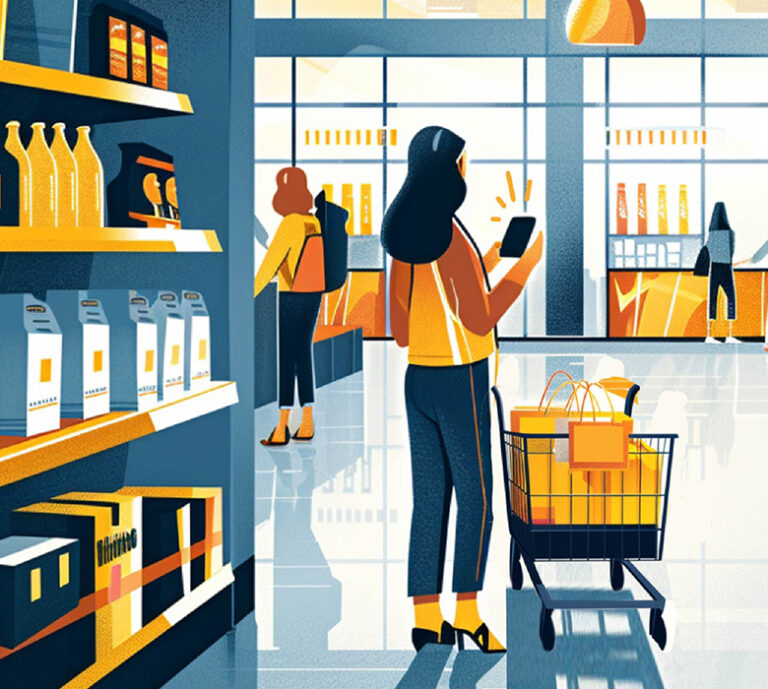×

In Fast Company, we share how brands can measure the power of their physical customer experience, what's holding them back, and more.

Our Managing Director, Andrew Carpenter, spoke with Oliver Chen, Managing Director and Senior Equity Research Analyst at TD Cowen whose expertise lies in all things retail, luxury goods, and new platforms. Oliver is also a professor at Columbia Business School, teaching the course ‘New Frontiers in Retailing: Magic and Logic.’
In this edition of our expert interview, ChangeUp tapped Oliver to help paint the picture of retail’s future and understand the impact of AI not only on the customer, but on the broader set of stakeholders that depend on brands for goods and services, jobs, and stock performance.
Andrew: Oliver, your lens of retail is quite wide. From covering stocks, to teaching future retail leaders, to being a consumer yourself, let’s start more broadly and talk about some of the things you are most surprised or excited by when you think about the future of retail.
Oliver: I’m always a big proponent of physical stores. Yes, customers have elevated expectations today because we are in this age of receiving everything, anywhere, right now. Speed and convenience is required to win in the marketplace as retail must offer the full range of buy-online-pick-up-in-store to curbside-pickup to drone delivery. The same customer will use multiple ways and follow different journeys on the path-to-purchase and path-to-receive goods depending on need states and context. But at the end of the day, customers also still love discovery and value community. Customers also love treasure hunts and coherent and exciting experiences that surprise, delight, and amaze!
And in order to provide them with a successful, holistic customer experience, I believe 3 components need to exist: A “connected” experience, a “community” experience, and “context” (meaning how you drive personalization.) There’s so much opportunity for innovation within each of these, that I’m still excited for what’s to come in physical retail.
Speaking of innovation, I’m also excited about AI and how it can capture and enable change faster than anything we have seen before. It offers both magic and logic. It’s exciting to see how it’s permeating through business today, in everything from product innovation, to marketing and design, to supply chain and inventory management. We are in the very early stages of understanding its impact on customers and brands. There’s been remarkable progress in more efficient inventory management and the transformation of product search and discovery.
Andrew: One question in, and we’re already talking about AI. AI is no doubt the buzziest topic across all industries and the world. Yet unlike the prior technologies that dominated headlines and keynotes, (i.e. metaverse, voice, or NFTs), AI feels like a technology that can in the very short term grow the top and bottom line, while also unlocking experiences that delight customers. What are a few ways you see AI impacting retail?
Oliver: Where we see AI playing a role is in MLI (merchandising, labor, and inventory.) Its value will continue to be in reducing extra inventory, increasing full price sales, and saving labor.
AI will be great for retail because it will give good salespeople time to focus on what matters, connecting with and helping customers. If it’s used correctly, brands can rely upon systems to drive training and services that employees don’t like doing, thereby freeing them up to be more human. Front-facing talent in-store is critical to thrive, so in order to retain great talent, this will be a huge recipe for success.
Additionally, as we think about AI, the principles are really adaptation and optimization, and retailers will need to embrace this aggressively. One of the first use cases we think about is how AI can help retailers adapt to variables that are outside of their control. For example, understanding things like competitor pricing, product launches, and even weather, is something AI can do faster than any human. When one of these variables presents itself, AI can notify the retailer, recommend a response, and communicate or implement an action at a rate never before dreamed of. Not only will this dramatically impact revenue and expenses, but it will create opportunities to surprise and delight customers.
All of this said, AI is still very much human-dependent. We need to consider how humans can harness the best of this technology because it requires a lot of human intervention, more than people appreciate to a certain extent.
Andrew: Absolutely agree. AI holds a lot of promise in way that are both visible and invisible to the customer. We are in the early stages of companies investing in AI and it seems like investors are being patient, at least for now, with demonstrating ROI from those investments. Could you speak a bit about how you have you seen brands communicate and promise long-term value to the customer while also delivering short-term performance?
Oliver: These are the types of tough decisions that businesses need to make. You have different brands with different types of customers and stakeholder interests. But brands can’t be everything to everybody. So, brands, and specifically retailer brands have to know what they stand for, make their priorities clear, be transparent, and adjust appropriately when need be. It’s about engagement, and balancing business priorities across stakeholders, which includes everyone from suppliers to shareholders to customers and employees. Management teams also need to view and embrace AI as a social science because the bigger challenges will most likely relate to design, implementation, execution, and revisions rather than technical in nature. Humans are essential for AI models given the tailoring required to drive impact as well as the safety and privacy and control concerns.
Take the issue of sustainability, for example. A challenge with being sustainable as a company is it’s expensive and can impact short-term margins but can have long-term purpose and meaning and impact. Additionally, maybe a subset of your customer base may not be willing to pay extra for it. However, for some retailers it may be a core pillar of their brand and align them with a growing subset of their customer base. So not only does investing in a long-term initiative show customers you authentically care, I like to believe that we’re entering an era where mission and purpose are critically important to drive success. Also, it’s obviously positive to leave the world in a better place. Retailers and brands and factories will need to explore new ways of collaborating in order to drive lasting change.
Andrew: Similarly to the previous question, you mention shareholders – Can you share more about how to balance stock performance vs. steps the business is taking to perform?
Oliver: A principle in stock performance is reducing your standard deviation relative to stated guidance and planning. The challenge of reducing volatility is we’ve had unprecedented shocks to demand, society, and the world. Can you translate those shocks to a smoother earnings per share, or not? When you have problems, do you have the power to offset those or are you just vulnerable? Are you vulnerable to the economic data or can you outperform? For instance, if a retailer is performing well – is it because the industry is, or is it because the business actually delivers value? Furthermore, a framework we use is customer lifetime value. To keep it simple: you want to retain and not lose customers, you want them to be profitable customers who last a lifetime, and you want to manage spending to acquire these customers. You will lose customers if you do not offer the right price, value, experience, and innovation ratios. And this is ever evolving as the landscape and nature of competition changes.
Andrew: Completely agree, some businesses are seeing their market cap rise because they are an exceptional business, while others may be capitalizing on economic opportunity. What do you think are the similarities in the brands that are performing well? Would you mind sharing a few?
Oliver: The pace of change in retail is accelerating so fast, so the similarities between the brands that are performing is they have excellent leadership teams, ones that are able to bounce back from problems and change. Also, the nature of what innovation means is different across sectors and companies but it’s essential. Innovation can come in the form of emotional innovation, product efficacy, value to the customer, relevant and transformational newness, medicalization, and cultural relevance, among others. Innovation is what makes retail fun, challenging, and ever changing. It also requires a certain degree of “thoughtful” failures too, in my view.
We’re excited about e.l.f. Beauty and Louis Vuitton who have been culturally relevant and reliable players in this space. When you think about mission-based brands, we appreciate brands like Levi’s who have done a really good job with sustainability and how to help the industry as a whole when it comes to the environment. Costco is a business that does a great job of really thinking about their employees and how to offer them real value and an exciting career path. We’re also impressed by Walmart’s new private brand innovation, technology and artificial intelligence focus, and consistent talent and execution in grocery.
At a high level, brands that stay relevant are those with an innovative team of diverse thinkers.
Get more insights and trend forecasting from Oliver Chen here.


